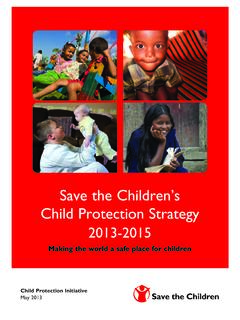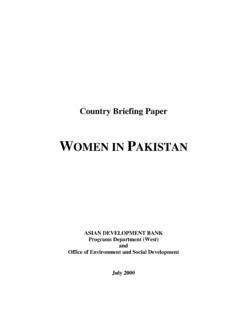Transcription of Nou˜ishing India - NITI
1 Nourishing India N AT I O N A L N U T R I T I O N S T R AT E GY, GOVERNMENT OF India . National Nutrition Strategy INDEX. Sr. No Content Page No. Glossary of Acronyms 2. List of Figures & Tables 5. 1 Nutritional Situation Analysis 6. 2 Identification of Focus Districts- Including Poor Performing States and Districts 22. 3 Vision 2022 24. 4 Goals, Objectives & Key Indicators 25. 5 Guiding Principles 27. 6 Nutrition Interventions 29. 7 Nutrition Strategy- How? 39. 8 Monitoring, Tracking & Recognizing Progress 52. 9 Research & Evaluation 57. 10 Convergence of Multi Sectoral Interventions 59. 11 The Role Of Panchayati Raj Institutions And Urban Local Bodies 69. 12 Institutional Arrangements 71. 13 Estimated Resource Requirement 80. 14 Annexure I: List of References 81. 15 Annexure II: District Analysis 84. 16 Annexure III: 100 Poor Performing Districts with respect to Stunting 109. National Nutrition Strategy Glossary of Acronyms AIIMS All India Institute of Medical Sciences ANC Antenatal Care APIPs Annual Programme Implementation Plans ARI Acute Respiratory Infections ASHA Accredited Social Health Activist AWC Anganwadi Centre AWTC Anganwadi Workers' Training Centre AWW Anganwadi Worker BCC Behaviour Change Communication BMI Body Mass Index BPL Below Poverty Line BPNI Breastfeeding Promotion Network of India CEO Chief Executive Officer CGS child Growth Standards CRM Common Review Mission DG Director General DLHS District Level Household Survey GMP Growth Monitoring and Promotion GOI Government of India HBNC Home Based Newborn Care HH Households HMIS Health Management Information System HRD Human Resource Development ICDS Integrated child Development Services Scheme ICMR Indian Council of Medical Research IDA Iron DeficiencyAnemia IDD Iodine Deficiency Disorders IEC Information, Education.
2 Communication IFA Iron Folic Acid IIPS International Institute of Population Sciences IPMS Integrated Performance Management System ISSNIP ICDS Systems Strengthening & Nutrition Improvement Project IVR Interactive Voice Response 2. National Nutrition Strategy IYCF Infant and Young child Feeding JE Japanese Encephalitis LBW Low Birth Weight M&E Monitoring and Evaluation MSY Matritva Sahyog Yojana MCPC Mother and child Protection Card (ICDS and NHM). MCTS Mother and child Tracking System (NHM). MIS Management Information System MLTC Mid Level Training Centre MDM Mid Day Meal MDWS Ministry of Drinking Water and Sanitation MHRD Ministry of Human Resource Development MNREGA Mahatma Gandhi National Rural Employment Guarantee Act MOHFW Ministry of Health and Family Welfare MRD Ministry of Rural Development MWCD Ministry of Women and child Development NFI Nutrition Foundation of India NNM National Nutrition Mission NFHS National Family Health Survey NGOs Non Government Organizations NHM National Health Mission NHSRC National Health Systems Resource Centre NIHFW National Institute of Health and Family Welfare NIN National Institute of Nutrition NNM National Nutrition Mission NNMB National Nutrition Monitoring Bureau NNRC National Nutrition Resource Centre NSSO National Sample Survey Organisation ORS Oral Rehydaration Salt PMMVU Pradhan Mantri Matru Vandana Yojana PDS Public Distribution System PIPs Programme Implementation Plans PMO Prime Minister's Office PRI
3 Panchayati Raj Institutions RCH Reproductive and child Health 3. National Nutrition Strategy RMNCH +A Reproductive, Maternal , Newborn, child and Adolescent Health SABLA Rajiv Gandhi Scheme for Empowerment of Adolescent Girls SAM Severe Acute Malnutrition SHG Self Help Group SIHFW State Institute of Health and Family Welfare SNP Supplementary Nutrition Programme SNRC State Nutrition Resource Centre TORs Terms of Reference THR Take Home Ration ULB Urban Local Body VAD Vitamin A Deficiency VHND Village Health and Nutrition Day VHSNC Village Health Sanitation and Nutrition Committee WCD Women and child Development 4. National Nutrition Strategy List of Figures/ Table and Boxes (in order of appearance). Figure 1 child Undernutrition Figure 2 Underweight Prevalence in Children (0-5 years). Figure 3 Stunting in Children (0-5 years). Figure 4 Wasting in Children (0-5 years). Figure 5 Percentage of Women with Low BMI. Figure 6 Anemia in Women & Girls (15-49 years). Figure 7 Institutional Births Figure 8 At Least 4 ANCs Figure 9 Exclusive Breastfeeding in India Figure 10 Anemia in Children (6-59 months).
4 Figure 11 Rural Households with Toilet Coverage (%). Figure 12 Ranking of Districts on the basis of Prevalence of Stunting among Children under 5. years Figure 13 High Burden/ Priority Districts of ICDS, ISSNIP & NHM. Figure 14 The Vision- Kuposhan Mukt Bharat Figure 15 Monitorable Outcomes Figure 16 Nutrition Interventions Figure 17 Infant & Young child Care & Nutrition Figure 18 Infant & Young child Health Figure 19 Maternal Care, Health & Nutrition Figure 20 Adolescent Nutrition Figure 21 Guidelines for Control of Iron Deficiency Anemia (MoH&FW). Figure 22 Community Nutrition Figure 23 Core Strategy- How Figure 24 Enabling Actions Figure 25 Major Programmes & Concerned Departments Figure 26 Convergence'- Role of Different Ministries 5. National Nutrition Strategy 1.. NUTRITIONAL SITUATION ANALYSIS. NUTRITION: CENTRE STAGE IN THE NATIONAL DEVELOPMENT AGENDA. The rationale for investing in Nutrition is globally well recognized both as a critical development imperative, as well as crucial for the fulfillment of human rights- especially of the most vulnerable children, girls and women.
5 It constitutes the foundation for human development, by reducing susceptibility to infections, related morbidity, disability and mortality burden, enhancing cumulative lifelong learning capacities and adult productivity. Nutrition is acknowledged as one of the most effective entry points for human development, poverty reduction and economic development, with high economic returns. Undernutrition is both a consequence as well as a cause of perpetuating poverty, eroding human capital through irreversible and intergenerational effects on cognitive and physical development. This intergenerational cycle of undernutrition, manifest as low birth weight, is compounded by gender discrimination and social exclusion. Nutrition status of the most vulnerable age group of children is also a sensitive proxy indicator of human development and of the effectiveness of national socio economic development strategies. The Global Nutrition Report 2015 estimates that for investment in nutrition, there is a benefit cost ratio of 16:1 for 40 low and middle-income countries.
6 Nutrition is central to the achievement of other National and Global Sustainable Development Goals. It is critical to prevent undernutrition, as early as possible, across the life cycle, to avert irreversible cumulative growth and development deficits that compromise maternal and child health and survival ;. and undermine the achievement of optimal learning outcomes in elementary education, impairing adult productivity and undermining gender equality. High levels of maternal and child undernutrition in India have persisted, despite strong Constitutional, legislative policy, plan and programme commitments. Legislations such as the National Food Security Act 2013 mandating food and nutrition entitlements for children, pregnant and breastfeeding mothers with maternity support and the Infant Milk Substitutes, Feeding Bottles and Infant Foods (Regulation of Production, Supply and Distribution) Act 1992, and Amendment Act 2003 provide a strong policy framework for protecting, supporting and promoting nutrition interventions especially during periods of greatest vulnerability for children and women.
7 The National Nutrition Policy 1993, complemented by other policies such as the National Health Policy 2002, the National Policy for Children, 2013 provides a strong foundation for addressing the immediate and the underlying determinants of undernutrition through both direct interventions and indirect interventions. The Twelfth Five Year Plan reinforced the commitment to preventing and reducing child undernutrition (underweight prevalence in children 0-3. years), articulated as one of its core Monitorable Targets, binding multiple sectors and States to collective action. 6. National Nutrition Strategy A wide spectrum of national programmes contribute to improved nutrition outcomes, addressing both the immediate and the underlying determinants of undernutrition through nutrition specific and nutrition sensitive interventions. These include the Integrated child Development Services, National Health Mission- including RMNCH + A, Janani Suraksha Yojana, Swachh Bharat including Sanitation and the National Rural Drinking Water Programme, Matritva Sahyog Yojana, SABLA for adolescent girls, Mid Day Meals Scheme, Targeted Public Distribution System, National Food Security Mission, Mahatma Gandhi National Rural Employment Guarantee Scheme and the National Rural Livelihood Mission- among others.
8 The policy commitment to preventing and reducing undernutrition was reaffirmed by the Budget 2014-15 speech of the Finance Minister, which stated that - A national programme in Mission Mode is urgently required to halt the deteriorating malnutrition situation in India , as present interventions are not adequate. A comprehensive strategy including detailed methodology, costing, time lines and monitorable targets will be put in place within six months. Guided by this policy direction, the Ministry of Women and child Development also formulated a proposal for a National Nutrition Mission, building on the recommendations from a National Consultation, an Expert Advisory Group was constituted in 2014. This policy direction was reinforced by the PMO, mandating NITI Aayog to examine the emerging data on undernutrition and prepare, in consultation with the Ministries of WCD and Health, a specific strategy for poor performing states/districts. This has brought Nutrition center-stage on the National Development Agenda and is the policy context within which this National Nutrition Strategy has been been formulated, through a consultative processes.
9 child UNDERNUTRITION. India is home to the largest number of children in the world. Nearly every fifth young child in the world lives in India . It is estimated that there are about 43 crore children in the age group of 0-18 years. Children and women together constitute around 70% of India 's people representing not just the Figure 1. child Undernutrition 48. NFHS-3. 21 NFHS-4. Stunting Wasting Underweight 7. National Nutrition Strategy present human resource base but also the future. This resource base is eroded by undernutrition - which undermines their survival , health, cumulative learning capacities and adult productivity and must be urgently addressed. child Undernutrition remains high, despite improvements over the last decade. Figure 1 compares the primary indicators of child undernutrition - stunting, wasting and underweight, for children below five years of age. As evident, while stunting and underweight prevalence has gone down, trends in wasting show an overall increase in the last decade.
10 The decrease in stunting has been from 48% to , that is, by 1 percentage point per year. Similarly, underweight prevalence has reduced by percentage points from NFHS-3 to NFHS-4. Recent data, especially for challenging states is promising, suggestive of acceleration. However, the pace of reduction remains low and calls for focused interventions in the area for optimal results. Underweight Prevalence in Children In India , undernutrition levels have remained persistently high especially in utero, in the early years of life, in adolescent girls and in women across the life cycle-especially in disadvantaged /excluded community groups and those living in areas or conditions of high nutritional vulnerability and multiple deprivations. National level estimates which have been used for drawing comparison are the NFHS-3. (2005-06) and NFHS-4 (2015-16). Figure 2. Underweight Prevalence in Children (0-5 Years). 80. 60. 40. 20. 0. All India Andman &. Andhra Arunachal Assam Chandigarh Chhattisgarh Dadra & -gar Daman &.

















